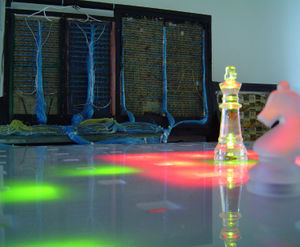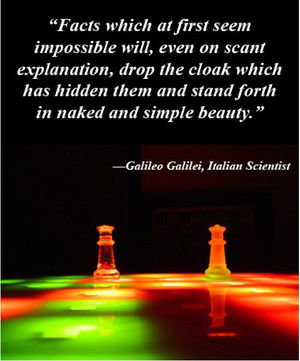First-Hand:Parallel Processor, Theory and Circuits
Submitted by Raymond Dudley
The parallel processor, theory and circuits, was invented in the spring of 1973 in El Cajon, California.
A demonstration machine was created (United States Patent 4,391,447). [1]
“ a chess set comprising a playing board and a plurality of playing pieces, each piece being movable between playing positions on the playing board in accordance with a predetermined pattern which is influenced by the locations of other playing pieces. Each playing piece is encoded in accordance with its identity, and each playing position automatically responds to the encoding when it is occupied by a playing piece. An electrical circuit associated with the playing position causes other positions to which the playing piece is capable of moving to be illuminated with an appropriate color. Each playing piece includes light sources which are illuminated when the playing piece is in jeopardy of being captured by an opposing playing piece or is covered by a friendly playing piece. The intensity of attack and the depth of cover may also be indicated.”
“...a machine that could breakdown a problem, allocate its parts to 64 square computer processors, solve the problem in parts and put all the solutions back together again for a final result.”[2]
“There are many variations on FPGA design, but the basic structure consists of a large number of configurable logic blocks and a programmable grid of connections that can link those blocks in any pattern the designer chooses.”[3]
“On the other hand, massively parallel machines are inherently scalable, meaning that the same design could be used with 4,000 or 400 or 4 microprocessors, providing incrementally lower performance but at a lower cost.”[4]
“Problems can be solved faster with more processors, but only if they are divided into tasks that take advantage of all the processors.” [5]
“The biggest obstacle to massively parallel computing is software. It is difficult to break up programs so that they can be gang-tackled by many electronic brains at once. Many programmers aren't familiar with the custom-made operating systems typically used to control basic functions of parallel machines.”[6]
“Recognition is the prize in science, and scientists in all fields compete for credit and fame. Increasingly in recent years this competition has led to 'Publication by Press Conference' ”[7]
“Researchers could only build toy applications.”[8]
“The American economy is driven by the innovation and creativity of its people. We need to protect the ideas and artistry that has made us so successful.”[9]
Basic research is expensive. When you do not have money, you have to use time. This required sacrifices in construction. The circuits, consisting of more than 1,500 series 7400 TTL's, had to be hard-wired as the sockets cost more than the chips. The LED's for the light board (representing 1,512 data points) cost over $1.00 each. I received no funding or grants to finance this project. The development of the parallel processor/spreadsheet/non Von Neumann architecture is the story of the development of the chess computer which ultimately culminated in IBM's Deep Blue.
Timeline
- 1973 – Began patent proceedings
- 1981 - Belle Chess Computer, “The secret of its success is special hardware designed explicitly to carry, out chess calculations.”, Scientific American April 1981
- 1982 - Chess-Playing Computer Seized by Customs Gina Kolata “I can buy one for $1000 cash in New York City with no questions asked.” Joseph Condon co-designer AT&T Bell Labs, Science, Vol. 216, June 25, 1982
- 1982 - National Security Even Includes Chess Secrets Noel Osment, “a fairly mundane microcomputer and some specially built hardware that, enables it to play chess very fast. It's certainly priceless. It's all handbuilt.”, Kenneth Thompson co-designer AT&T Bell Labs
- 1983 – Patent published, United States Patent 4,391,447
- 1984 – Game of Chess Gets Modern-Day Twist Ron Harrist, “his program required that the moves determined by a computer be physically carried out on a real chess board.”, The Day, New London, Conn., Monday, Jan. 16, 1984
- 1985 – Two Firms Unveil Computers Linking Many Processors, David Stipp and Bob Davis, “Researchers could only build toy applications.”, Wall Street Journal, May 3, 1985
- 1987 - Competition, Dreams Power Computer Race James Flanigan, “Supercomputer technology is not developed in a garage.”, Los Angeles Times, Wednesday, December 30, 1987
- 1988 - Faster Computers: Race Is On John Markoff, “ Parallel processing is based on dividing a complex problem into many small pieces and putting a multitude of machines to work simultaneously on the pieces.” The New York Times, June 16, 1988
- 1993 - GAO: Tech Agency Plays Favorites Tom Abate, “ What we're looking at is a major technology transition as profound as the original move to computers in the first place. You just don't throw this stuff over the fence.”, San Francisco Examiner, Sunday, May 16, 1993
- 1994 - Software is Firm's Legacy Michael Schrage, “Danny Hillis' essential idea was that a computer with thousands of processors could, like a swarm of hungry piranha, nibble a large problem to death far faster than a giant single processor.”, Innovation Sunday, August 28, 1994
- 1995 - Shifting Lead at Forefront of Computing Lawrence M. Fisher, “massively parallel machines are inherently scalable, meaning that the same design could be used with 4,000 or 400 or 4 microprocessors, providing incrementally lower performance but at a lower cost.”, The New York Times, Monday, September 11, 1995
- 1997 - Configurable Computing, John Villasenor and William H. Mangione-Smith, “There are many variations on the FPGA design, but the basic structure consists of a large number of logic blocks and a programmable grid of connections that can link those blocks in any pattern the designer chooses. Scientific American, June 1997
References
- ↑ http://patft.uspto.gov/netacgi/nph-Parser?Sect1=PTO1&Sect2=HITOFF&d=PALL&p=1&u=/netahtml/PTO/srchnum.htm&r=1&f=G&l=50&s1=4,391,447.PN.&OS=PN/4,391,447&RS=PN/4,391,447
- ↑ Competition, Dreams Power Computer Race, from the Los Angeles Times, Wednesday, Dec 30th, 1987 by James Flanigan, http://parallelprocessor.info/1987.php
- ↑ Configurable Computing, from Scientific American June 1997 by John Villasenor and William H. Mangione-Smith, http://xputers.informatik.uni-kl.de/reconfigurable_computing/villasenor/0697villasenor.html
- ↑ Shifting Lead At Forefront Of Computing, from The New York Times, Monday, September 11, 1995 by Lawrence M. Fisher, http://parallelprocessor.info/1995.php
- ↑ Overcoming obstacles, from The San Francisco Examiner, Sunday, April 28, 1991 by Paul Freiberger, http://parallelprocessor.info/1991-overcoming.php
- ↑ Intel Rolls Out New Supercomputer Today, from the San Francisco Chronicle, Monday, November 18, 1991 by Don Clark, http://parallelprocessor.info/1991.php
- ↑ The Burden of Proof, from The Los Angeles Times, December 4, 1986, http://parallelprocessor.info/1986.php
- ↑ Two Firms Unveil Computers Linking Many Processors, from The Wall Street Journal, May 3, 1985 by David Stipp and Bob Davis, http://parallelprocessor.info/1985c.php
- ↑ Releasing the Joint Strategic Plan to Combat Intellectual Property Theft, from The White House Blog, June 22, 2010 posted by Victoria Espinel, U.S. Intellectual Property Enforcement Coordinator, https://www.whitehouse.gov/blog/2010/06/22/releasing-joint-strategic-plan-combat-intellectual-property-theft
All the quotes cited are linked to full articles at:









